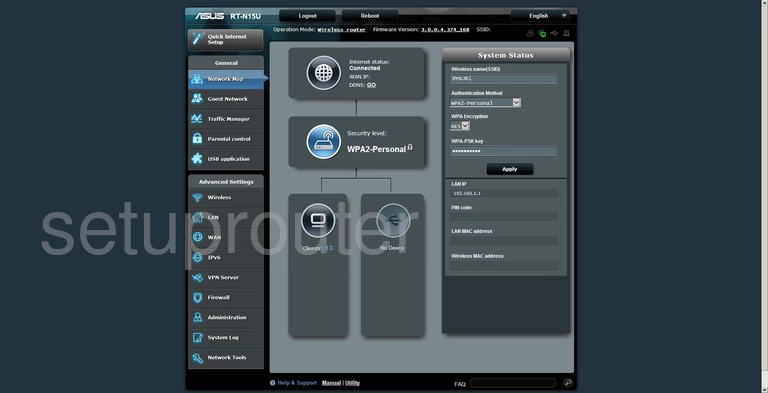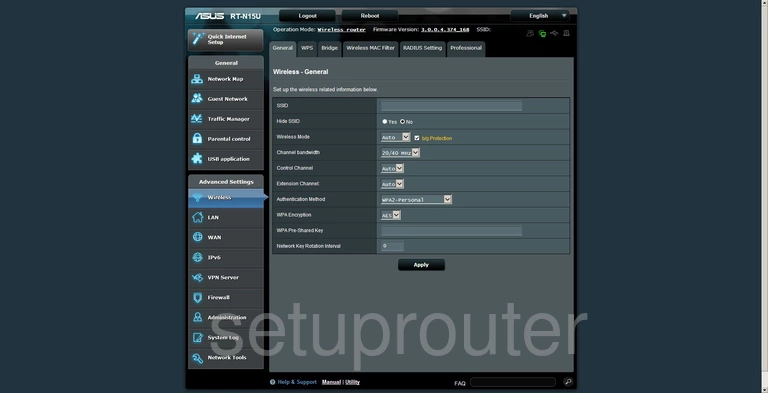The Asus RT-N15U router is considered a wireless router because it offers WiFi connectivity. WiFi, or simply wireless, allows you to connect various devices to your router, such as wireless printers, smart televisions, and WiFi enabled smartphones.
Other Asus RT-N15U Guides
This is the wifi guide for the Asus RT-N15U. We also have the following guides for the same router:
WiFi Terms
Before we get started there is a little bit of background info that you should be familiar with.
Wireless Name
Your wireless network needs to have a name to uniquely identify it from other wireless networks. If you are not sure what this means we have a guide explaining what a wireless name is that you can read for more information.
Wireless Password
An important part of securing your wireless network is choosing a strong password.
Wireless Channel
Picking a WiFi channel is not always a simple task. Be sure to read about WiFi channels before making the choice.
Encryption
You should almost definitely pick WPA2 for your networks encryption. If you are unsure, be sure to read our WEP vs WPA guide first.
Login To The Asus RT-N15U
To get started configuring the Asus RT-N15U WiFi settings you need to login to your router. If you are already logged in you can skip this step.
To login to the Asus RT-N15U, follow our Asus RT-N15U Login Guide.
Find the WiFi Settings on the Asus RT-N15U
If you followed our login guide above then you should see this screen.

This guide begins on the Network Map page of the Asus RT-N15U router. To configure the WiFi settings, click the link on the left side of the page labeled Wireless. Then be sure that the General tab is chosen at the top of the page.
Change the WiFi Settings on the Asus RT-N15U

The first thing you need to do on this page is change the SSID. This is the name of your network. You need to create an original name here, but avoid using any personal information. Wireless names is a great guide on the topic if you are interested.
Just below that is the option of Hide SSID. This is by default off, meaning that your network is visible to all surrounding wireless devices. If you choose to click Yes hide my SSID, it is invisible to wireless devices. It is still visible to a hacker with the proper scanning tools though.
Go ahead and leave the next two Wireless Mode, and Channel bandwidth at their default settings.
Below that is the Control Channel and this should at least be checked. You need to be using either channel 1,6, or channel 11. In the United States there are a total of 11 channels. There is only room in the spectrum for three of those 11 channels that do not overlap each other, channels 1,6, and 11. WiFi channels is a good guide on the topic if you are interested in knowing more.
Leave the Extension Channel at the default setting.
The Authentication Method is referring to the security you want to use while transmitting data on the airwaves. There are several choices here, we recommend using WPA2-Personal. Check out our guide on the topic, WEP vs. WPA for more information.
Next is the WPA Encryption. Now that you have decided on the type of security you are going to use, choose the type of encryption to go along with that security. There are two choices here. TKIP which is older and flaws have been found, or AES which is an updated form of encryption that has yet to be cracked. AES is the encryption we recommend.
Under that is the WPA Pre-Shared Key. This is the password you use to access your network. This is an important step. Create a strong password with at least 20 characters. Avoid using any personal information here. You should also avoid using any word that can be found in a dictionary. We do recommend using some symbols, capital letters, and numbers here. How to choose a strong password is a great guide if you need some more help in creating a strong and memorable password.
That's all that needs to be changed to properly configure your WiFi.
Possible Problems when Changing your WiFi Settings
After making these changes to your router you will almost definitely have to reconnect any previously connected devices. This is usually done at the device itself and not at your computer.
Other Asus RT-N15U Info
Don't forget about our other Asus RT-N15U info that you might be interested in.
This is the wifi guide for the Asus RT-N15U. We also have the following guides for the same router: